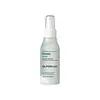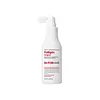What's inside
What's inside
 Key Ingredients
Key Ingredients

 Benefits
Benefits

 Concerns
Concerns

 Ingredients Side-by-side
Ingredients Side-by-side

Hamamelis Virginiana Water
AstringentWater
Skin ConditioningAlcohol
Antimicrobial1,2-Hexanediol
Skin ConditioningPentylene Glycol
Skin ConditioningSilica
AbrasiveGlycerin
HumectantLithium Magnesium Sodium Silicate
AbsorbentButylene Glycol
HumectantPhenoxyethanol
PreservativePPG-3 Caprylyl Ether
SolventCalcium Chloride
AstringentPEG-60 Hydrogenated Castor Oil
EmulsifyingParfum
MaskingCitric Acid
BufferingLimonene
PerfumingLinalool
PerfumingBenzyl Salicylate
PerfumingAlgin
MaskingSalix Alba Bark Extract
AstringentButyl Avocadate
Skin ConditioningMelaleuca Alternifolia Leaf Extract
PerfumingMaltodextrin
AbsorbentMoringa Oleifera Seed Extract
Skin ConditioningCamellia Japonica Flower Extract
EmollientAnthemis Nobilis Flower Extract
MaskingRhus Semialata Gall Extract
Skin ConditioningRosmarinus Officinalis Leaf Extract
AntimicrobialDipropylene Glycol
HumectantMentha Viridis Extract
MaskingOriganum Vulgare Leaf Extract
Skin ConditioningMelilotus Officinalis Extract
AstringentBambusa Vulgaris Water
Skin ConditioningCalendula Officinalis Flower Extract
MaskingGardenia Taitensis Flower Extract
Skin ConditioningLavandula Angustifolia Flower Extract
CleansingSaponaria Officinalis Leaf Extract
AntimicrobialTocopherol
AntioxidantOenothera Biennis Flower Extract
AstringentPinus Palustris Leaf Extract
TonicPueraria Thunbergiana Root Extract
Skin ConditioningUlmus Davidiana Root Extract
Skin ConditioningEthylhexylglycerin
Skin ConditioningHamamelis Virginiana Water, Water, Alcohol, 1,2-Hexanediol, Pentylene Glycol, Silica, Glycerin, Lithium Magnesium Sodium Silicate, Butylene Glycol, Phenoxyethanol, PPG-3 Caprylyl Ether, Calcium Chloride, PEG-60 Hydrogenated Castor Oil, Parfum, Citric Acid, Limonene, Linalool, Benzyl Salicylate, Algin, Salix Alba Bark Extract, Butyl Avocadate, Melaleuca Alternifolia Leaf Extract, Maltodextrin, Moringa Oleifera Seed Extract, Camellia Japonica Flower Extract, Anthemis Nobilis Flower Extract, Rhus Semialata Gall Extract, Rosmarinus Officinalis Leaf Extract, Dipropylene Glycol, Mentha Viridis Extract, Origanum Vulgare Leaf Extract, Melilotus Officinalis Extract, Bambusa Vulgaris Water, Calendula Officinalis Flower Extract, Gardenia Taitensis Flower Extract, Lavandula Angustifolia Flower Extract, Saponaria Officinalis Leaf Extract, Tocopherol, Oenothera Biennis Flower Extract, Pinus Palustris Leaf Extract, Pueraria Thunbergiana Root Extract, Ulmus Davidiana Root Extract, Ethylhexylglycerin
Water
Skin ConditioningAlcohol
AntimicrobialGlycerin
HumectantCaprylic/Capric Triglyceride
MaskingBiotin
AntiseborrhoeicCeramide NP
Skin ConditioningPanthenol
Skin ConditioningPropanediol
SolventAdenosine
Skin ConditioningMentha Piperita Oil
MaskingSerenoa Serrulata Fruit Extract
Skin ConditioningAllantoin
Skin ConditioningGanoderma Lucidum Extract
Skin ProtectingPanax Ginseng Root Extract
EmollientCaffeic Acid
AntioxidantRosmarinus Officinalis Leaf Extract
AntimicrobialEcklonia Cava Extract
Skin ConditioningUrtica Dioica Leaf Extract
Skin ConditioningRhodiola Rosea Root Extract
EmollientDioscorea Japonica Root Extract
Skin ConditioningPaeonia Lactiflora Root Extract
Skin ConditioningZingiber Officinale Root Extract
MaskingSophora Flavescens Extract
Skin ConditioningCaprylyl Glycol
EmollientLecithin
Emollient1,2-Hexanediol
Skin ConditioningEthylhexylglycerin
Skin ConditioningPolysorbate 80
EmulsifyingPEG-60 Hydrogenated Castor Oil
EmulsifyingDisodium EDTA
Citric Acid
BufferingSodium Citrate
BufferingParfum
MaskingWater, Alcohol, Glycerin, Caprylic/Capric Triglyceride, Biotin, Ceramide NP, Panthenol, Propanediol, Adenosine, Mentha Piperita Oil, Serenoa Serrulata Fruit Extract, Allantoin, Ganoderma Lucidum Extract, Panax Ginseng Root Extract, Caffeic Acid, Rosmarinus Officinalis Leaf Extract, Ecklonia Cava Extract, Urtica Dioica Leaf Extract, Rhodiola Rosea Root Extract, Dioscorea Japonica Root Extract, Paeonia Lactiflora Root Extract, Zingiber Officinale Root Extract, Sophora Flavescens Extract, Caprylyl Glycol, Lecithin, 1,2-Hexanediol, Ethylhexylglycerin, Polysorbate 80, PEG-60 Hydrogenated Castor Oil, Disodium EDTA, Citric Acid, Sodium Citrate, Parfum
 Reviews
Reviews

Ingredients Explained
These ingredients are found in both products.
Ingredients higher up in an ingredient list are typically present in a larger amount.
1,2-Hexanediol is a synthetic liquid and another multi-functional powerhouse.
It is a:
- Humectant, drawing moisture into the skin
- Emollient, helping to soften skin
- Solvent, dispersing and stabilizing formulas
- Preservative booster, enhancing the antimicrobial activity of other preservatives
Alcohol comes in many different forms. Different types of alcohol will have different effects on skin. This ingredient is usually an astringent alcohol.
These alcohols are drying on the skin. They may strip away your skin's natural oils and even damage your skin barrier. Astringent alcohols may also irritate skin.
Other types of astringent alcohols include:
According to the National Rosacea Society based in the US, you should be mindful of products with these alcohols in the top half of ingredients.
Any type of sanitizing product will have high amounts of alcohol to help kill bacteria and viruses.
Fatty alcohols come from plant oils such as coconut oil. These can help hydrate the skin and are non-irritating. Some fatty alcohols include cetyl and stearyl alcohol.
Learn more about AlcoholCitric Acid is an alpha hydroxy acid (AHA) naturally found in citrus fruits like oranges, lemons, and limes.
Like other AHAs, citric acid can exfoliate skin by breaking down the bonds that hold dead skin cells together. This helps reveal smoother and brighter skin underneath.
However, this exfoliating effect only happens at high concentrations (20%) which can be hard to find in cosmetic products.
Due to this, citric acid is usually included in small amounts as a pH adjuster. This helps keep products slightly more acidic and compatible with skin's natural pH.
In skincare formulas, citric acid can:
While it can provide some skin benefits, research shows lactic acid and glycolic acid are generally more effective and less irritating exfoliants.
Most citric acid used in skincare today is made by fermenting sugars (usually from molasses). This synthetic version is identical to the natural citrus form but easier to stabilize and use in formulations.
Read more about some other popular AHA's here:
Learn more about Citric AcidEthylhexylglycerin (we can't pronounce this either) is commonly used as a preservative and skin softener. It is derived from glyceryl.
You might see Ethylhexylglycerin often paired with other preservatives such as phenoxyethanol. Ethylhexylglycerin has been found to increase the effectiveness of these other preservatives.
Glycerin is already naturally found in your skin. It helps moisturize and protect your skin.
A study from 2016 found glycerin to be more effective as a humectant than AHAs and hyaluronic acid.
As a humectant, it helps the skin stay hydrated by pulling moisture to your skin. The low molecular weight of glycerin allows it to pull moisture into the deeper layers of your skin.
Hydrated skin improves your skin barrier; Your skin barrier helps protect against irritants and bacteria.
Glycerin has also been found to have antimicrobial and antiviral properties. Due to these properties, glycerin is often used in wound and burn treatments.
In cosmetics, glycerin is usually derived from plants such as soybean or palm. However, it can also be sourced from animals, such as tallow or animal fat.
This ingredient is organic, colorless, odorless, and non-toxic.
Glycerin is the name for this ingredient in American English. British English uses Glycerol/Glycerine.
Learn more about GlycerinParfum is a catch-all term for an ingredient or more that is used to give a scent to products.
Also called "fragrance", this ingredient can be a blend of hundreds of chemicals or plant oils. This means every product with "fragrance" or "parfum" in the ingredients list is a different mixture.
For instance, Habanolide is a proprietary trade name for a specific aroma chemical. When used as a fragrance ingredient in cosmetics, most aroma chemicals fall under the broad labeling category of “FRAGRANCE” or “PARFUM” according to EU and US regulations.
The term 'parfum' or 'fragrance' is not regulated in many countries. In many cases, it is up to the brand to define this term.
For instance, many brands choose to label themselves as "fragrance-free" because they are not using synthetic fragrances. However, their products may still contain ingredients such as essential oils that are considered a fragrance by INCI standards.
One example is Calendula flower extract. Calendula is an essential oil that still imparts a scent or 'fragrance'.
Depending on the blend, the ingredients in the mixture can cause allergies and sensitivities on the skin. Some ingredients that are known EU allergens include linalool and citronellol.
Parfum can also be used to mask or cover an unpleasant scent.
The bottom line is: not all fragrances/parfum/ingredients are created equally. If you are worried about fragrances, we recommend taking a closer look at an ingredient. And of course, we always recommend speaking with a professional.
Learn more about ParfumPeg-60 Hydrogenated Castor Oil comes from hydrogenated castor oil. It is a solubilizer and emulsifier.
As a solubilizer, it helps dissolve ingredients into a water-based version. It is also an emulsifer. Emulsifier help prevent oils and water from separating. Both these properties help create evenly-spread and uniform products.
Basically, Peg-60 Hydrogenated Castor Oil helps hold ingredients together.
Learn more about PEG-60 Hydrogenated Castor OilRosmarinus Officinalis Leaf Extract comes from rosemary. Rosemary is native to the Mediterranean.
While Rosmarinus Officinalis Leaf Oil can be volatile due to its fragrant properties, the fragrance components are usually removed in the leaf extract.
Rosemary Leaf Extract contains many antioxidants such as rosmarinic acid and caffeic acid. Rosemarinic acid, a compound found in rosemary leaf, has been found to help soothe skin conditions such as eczema and acne.
Learn more about Rosmarinus Officinalis Leaf ExtractWater. It's the most common cosmetic ingredient of all. You'll usually see it at the top of ingredient lists, meaning that it makes up the largest part of the product.
So why is it so popular? Water most often acts as a solvent - this means that it helps dissolve other ingredients into the formulation.
You'll also recognize water as that liquid we all need to stay alive. If you see this, drink a glass of water. Stay hydrated!
Learn more about Water